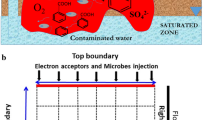Abstract
Microbes are ubiquitous in groundwater systems, and they play an important role in the redox state of groundwater and especially on the fate of organic contaminants. In this context, numerical simulations that couple microbial processes to reactive transport models are becoming more popular. In the present work, we revisit the mathematical ground of microbial redox reactions and perform a benchmark analysis of the simulation of aerobic benzene degradation in a shallow and oxidizing aquifer. Numerical results indicate that the two codes tested (one using the finite elements approach and the other using the finite differences approach) lead to very similar results. In addition, the coupling of heterogeneous geochemical reactions to the benchmarked example problem provides a solid basis for the understanding of the redox reactions and the changes on the carbon system triggered by the aerobic degradation of benzene.
Similar content being viewed by others
References
Acero P, Ayora C, Carrera J, Saaltink MW, Olivella S (2009) Multiphase flow and reactive transport model in vadose tailings. Appl Geochem 24:1238–1250
Alvarez PJJ, Anid PJ, Vogel TM (1991) Kinetics of aerobic biodegradation of benzene and toluene in sandy aquifer material. Biodegradation 2:43–51
Bain JG, Blowes DW, Robertson WD, Frind EO (2000) Modelling of sulfide oxidation with reactive transport at a mine drainage site. J Contam Hydrol 41:23–47
Barry DA, Prommer H, Miller CT, Engesgaard P, Brun A, Zheng C (2002) Modelling the fate of oxidisable organic contaminants in groundwater. Adv Water Resour 25:945–983
Bethke CM (2008) Geochemical and biogeochemical reaction modelling, 2nd edn. Cambridge University Press, Cambridge
Bethke CM, Yeakel S (2007) The geochemist’s workbench. Release 7.0. Reaction modeling guide. Hydrogeology program. University of Illinois, USA
Brookfield AE, Blowes DW, Mayer KU (2006) Integration of field measurements and reactive transport modelling to evaluate contaminant transport at a sulfide mine tailings impoundment. J Contam Hydrol 88:1–22
Brun A, Engesgaard P, Christensen TH, Rosbjerg D (2002) Modelling of transport and biogeochemical processes in pollution plumes: Vejen landfill, Denmark. J Hydrol 256:228–247
Canavan RW, Van Cappellen P, Zwolsman JJG, van den Berg GA, Slomp CP (2007) Geochemistry of trace metals in a fresh water sediment: Field results and diagenetic modelling. Sci Total Environ 381:263–279
Chapelle FH (1993) Groundwater microbiology and geochemistry. Wiley, New York
Christensen TH, Bjerg PL, Banwart SA, Jakobsen R, Heron G, Albrechtsen HJ (2000) Characterization of redox conditions in groundwater contaminant plumes. J Contam Hydrol 45:165–241
Jin Q, Bethke CM (2003) A new rate law describing microbial respiration. Appl Environ Microbiol 69:2340–2348
Jin Q, Bethke CM (2005) Predicting the rate of microbial respiration in geochemical environments. Geochim Cosmochim Acta 69:1133–1143
Mayer KU, Benner SG, Frind EO, Thornton SF, Lerner DN (2001) Reactive transport modelling of processes controlling the distribution and natural attenuation of phenolic compounds in a deep sandstone aquifer. J Contam Hydrol 53:341–368
Molinero J, Samper J (2006) Large-scale modeling of reactive solute transport in fracture zones of granitic bedrocks. J Contam Hydrol 82:293–318
Molinero JH, Samper FJC, Zhang G, Yang C (2004) Biochemical reactive transport model of the redox zone experiment of the Äspö hard rock laboratory in Sweden. Nucl Technol 148:151–165
Monod J (1949) The growth of bacterial cultures. Annu Rev Microbiol 3:371–394
Pérez-López R, Cama J, Nieto JM, Ayora C, Saaltink MW (2009) Attenuation of pyrite oxidation with a fly ash pre-barrier: Reactive transport modelling of column experiments. Appl Geochem 24:1712–1723
Postma D, Appelo CAJ (2000) Reduction of Mn-oxides by ferrous iron in a flow system: Column experiment and reactive transport modelling. Geochim Cosmochim Acta 64(7):1237–1247
Prommer H, Tuxen N, Bjerg P (2006) Fringe-controlled natural attenuation of phenoxy acids in a landfill plume: Integration of field-scale processes by reactive transport modeling. Environ Sci Technol 40(15):4732–4738
Steefel CI, Lichtner PC (1998) Multicomponent reactive transport in discrete fractures II: Infiltration of hyperalkaline groundwater at Maqarin, Jordan, a natural analogue site. J Hydrol 209:200–224
Thullner M, Van Cappellen P, Regnier P (2005) Modeling the impact of microbial activity on redox dynamics in porous media. Geochim Cosmochim Acta 69(21):5005–5019
van Breukelen BM, Appelo CAJ, Olsthoorn TN (1998) Hydrogeochemical transport modeling of 24 years of Rhine water infiltration in the dunes of the Amsterdam Water Supply. J Hydrol 209:281–296
Van Cappellen P, Gaillard J-F (1996) Biogeochemical dynamics in aquatic systems. In: Lichtner PC, Steefel CI, Oelkers EH (eds) Reactive transport in porous media. Rev Mineral 34:335–376
Wang Y, Van Cappellen P (1996) A multicomponent reactive transport model of early diagenesis: Application to redox cycling in coastal marine sediments. Geochim Cosmochim Acta 60(16):2993–3014
Watson IA, Oswald SE, Banwart SA, Crouch RS, Thornton SF (2005) Modeling the dynamics of fermentation and respiratory processes in a groundwater plume of phenolic contaminants interpreted from laboratory-to-field scale. Environ Sci Technol 39(22):8829–8839
Yang C, Samper J, Molinero J, Bonilla M (2007) Modelling geochemical and microbial consumption of dissolved oxygen after backfilling a high level radioactive waste repository. J Contam Hydrol 93:130–148
Zhang G, Samper J (2001) BIOCORE 2D: A code for water flow and reactive transport including surface microbial processes. User’s manual, Civil Engineering School, University of La Coruña, Spain
Author information
Authors and Affiliations
Corresponding author
Rights and permissions
About this article
Cite this article
Sena, C., Molinero, J., Ajima, S. et al. Modelling Microbial Degradation Coupled to Reactive Transport in Groundwater: A Benchmark Analysis. Math Geosci 44, 209–226 (2012). https://doi.org/10.1007/s11004-011-9375-0
Received:
Accepted:
Published:
Issue Date:
DOI: https://doi.org/10.1007/s11004-011-9375-0




